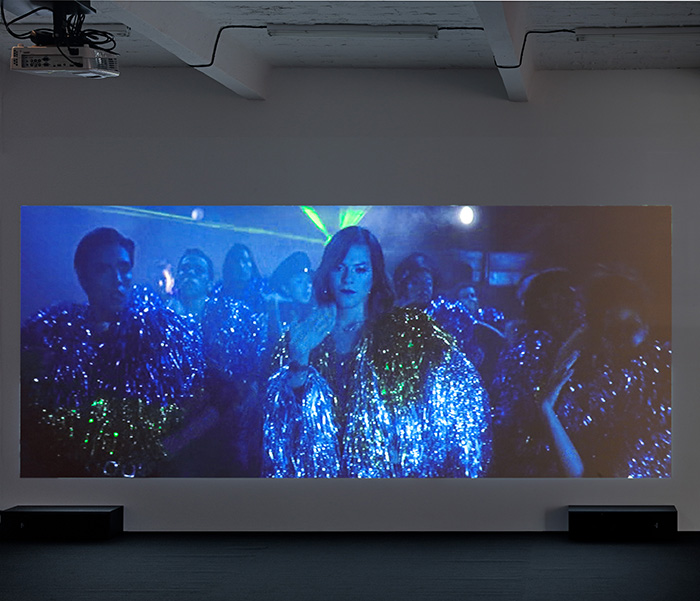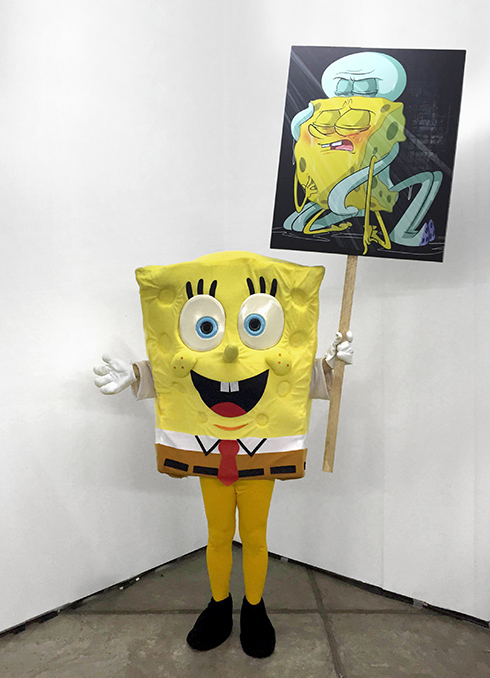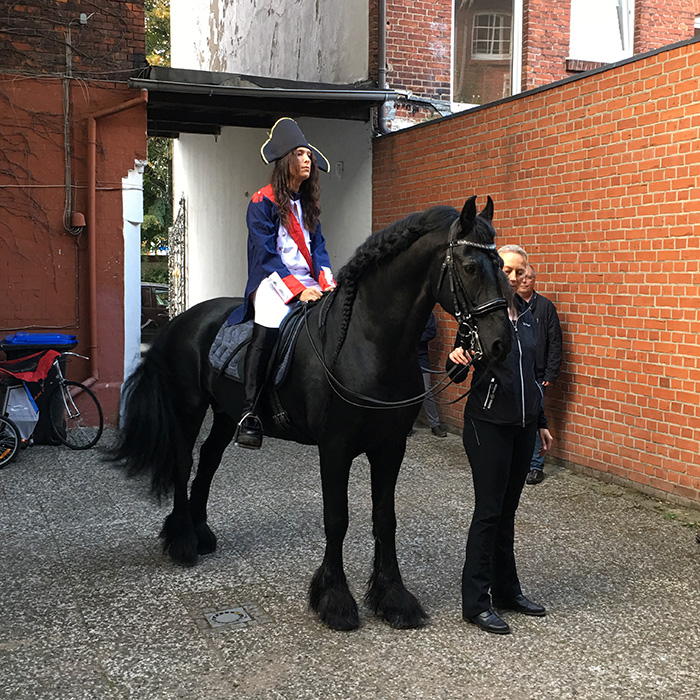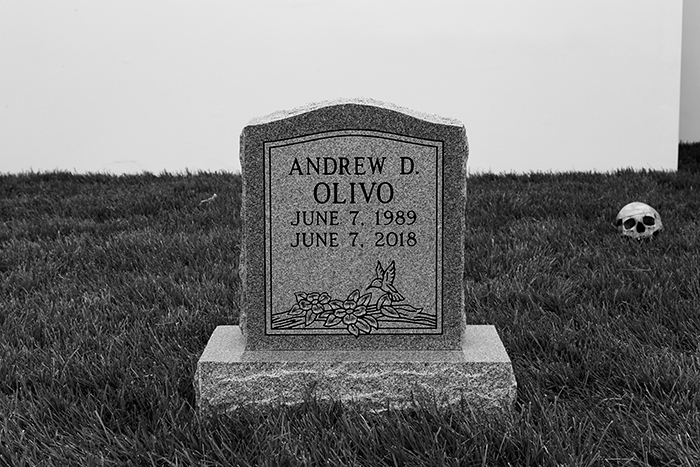I first encountered Puppies Puppies online, in a search-engine labyrinth of pop-culture overwhelm: Lord of the Rings, Frozen, SpongeBob SquarePants, Shrek, Harry Potter. These works were readymade portmanteaus – a condom stuffed with spaghetti, Voldemort’s head Photoshopped onto the body of a fashion model, the eye of Sauron gazing down from a New York City billboard. Other installations were built from impossibly mundane objects like waiting-line stanchions and hand-sanitiser dispensers. Initially I could find no name, image or consistent biographical information associated with the artist or artists who created the work. Likewise, the performances were costumed affairs, concealing all traces of their identity. As I followed the work, I noticed recurrent themes of health and body awareness, usually pitched to a gothic tone: an exhibition about the bubonic plague (at Halle für Kunst, Lüneberg, 2019), a show of the artist(s)’s blood (at Remai Modern, Saskatoon, 2019) during which HIV testing was offered and, at What Pipeline, Detroit, in 2018, a show about the death of ‘Andrew D. Olivo’, the former identity behind Puppies Puppies.
I first encountered Jade Kuriki Olivo, the newly transformed person behind Puppies Puppies, through an introductory email from her gallery. We soon met in person at a Japanese bakery in Lower Manhattan. She wore all black and parted her long, silky dark hair down the centre. Olivo had recently moved to New York from Los Angeles and had requested to meet early in the day so as to keep an appointment for acquiring a New York ID card. As we began speaking, I noticed that the café was playing music, primarily from Disney films, with songs from The Lion King (1994) and Beauty and the Beast (1991) on loop. This concerned me a little, as the belted ballads might drown out Jade’s gentle voice on the recording. But I’d recorded interviews in louder environments, and Olivo had limited time until their government appointment, so rather than move locations, I hoped for the best.
Our talk was immediately comfortable and intimate, thanks largely to Olivo’s generosity and vulnerability, and over the next few days I continued to replay moments from the conversation in my mind. But when I finally listened to the recording, our voices had mysteriously disappeared. Even in the moments between songs, when the environment around us fell silent, the recording didn’t register even the faintest murmur from our conversation.
The situation was unfortunate, and yet, considering the longtime anonymity of Puppies Puppies, this erasure felt appropriate. Unsure how to proceed, I wrote Olivo, who responded with measured calmness. “Is it possible for you to transcribe what you remember?” she wrote. “Memory driven. And I can look through it and make edits to fill in some gaps.”
So this is what we did. One week later, with reasonable accuracy, I recalled over 2,000 words of our conversation. I’d never attempted such an exercise before, and I attribute its success to the memorable quality of our talk. Once finished, Olivo reshaped their words and my own, and relabelled her answers to alternate between each of their monikers. What follows is a fully reimagined dialogue.
The artist with a live wolf in a field
Ross Simonini How long have you been in New York?
Jade Kuriki Olivo A month.
RS And why did you move?
Puppies Puppies My ex-partner and I got divorced. I couldn’t live in Los Angeles anymore. We moved there together. The city felt intensely full of memories and moments related to this relationship.
RS That seems like it was a pretty collaborative relationship. He did an interview in your place once, right?
JKO He’s an incredible writer. He used to write some of my press releases. I collaborate with people often. Almost everything I exhibit is a collaboration.
RS In what ways do you usually collaborate?
PP For example, in 2018 [at Galerie Barbara Weiss, Berlin] I collaborated with my friend Cielo Oscuro and photographed them on their first day of hormone replacement therapy. I gave her two weeks’ worth of hormones and blockers. Any profit made from these photographs goes towards helping fund Cielo’s transition. A few Instagram posts for her crowdfunding campaign were printed on vinyl and posted to the wall so anyone seeing the work could directly donate to her. In that same show, I also worked with the gallery to create a theatre and screened Sebastián Lelio’s film Una mujer fantástica (A Fantastic Woman, 2017) three times a day. Different reflective surfaces that the main character saw herself in were recreated (or I acquired readymade sculptures) and hung on the wall. A red LED digital-scrolling marquee announced the title of the film and the times it was screened throughout that day. Wheat-pasted posters for the movie were applied in various parts of Berlin. A billboard for the movie was also installed publicly. At the opening, right after the movie ended, there was a performer who recreated a profound dancing scene from the movie. A Fantastic Woman stars Daniela Vega, who is an exceptional (trans) actress.

RS When did you decide to transition?
JKO About two and a half years ago.
RS Was it a long time coming?
PP Yes, but I didn’t know it. I was unhappy for so long.
RS What did you look like then?
[JKO reaches into a bag and reveals an ID card with a picture of a strikingly different, bearded, shorthaired person and an old picture of the artist with a live wolf in a field]
RS Wow.
PP Yes. I have to reintroduce myself to people all of the time now.
A flesh-eating virus
RS Do you feel better now that you’ve transitioned?
JKO I feel good at times (it’s more like a rollercoaster of ups and downs). Much more relaxed with myself (but also not relaxed in certain situations…)
RS When did you start taking hormones?
PP Two years ago.
RS So only six months after you decided to hormonally transition. That’s a very quick decision.
JKO Yes, it was. Brain surgery helped me realise this is the only life I have to do what feels right.
RS When did the surgery happen?
PP In 2010. I was in Chicago and the tumour was discovered by chance. I was riding my bike and I got hit by a car. I had a cut on my head that bled very badly, as head wounds do. A police officer came to the scene and demanded that I take an ambulance, but I knew how much those things cost, so I just walked to the emergency room. They gave me a CT scan, and staples for the small gash. They thought I had a flesh-eating virus inside of my brain. I spent a week thinking that’s what I had. Then after an MRI they found a tumour. The neurosurgeon said he would monitor it, to see if it grew. It did. Over the next year, it started growing. So they had to surgically remove it.
RS How did your life change after that surgery?
JKO I was worried that I wouldn’t be an artist after the surgery, but I continued producing art. I smoked a lot of weed because I was depressed and I thought it was the only way I could cope. Afterward, I started becoming more impulsive. I was telling the people closest to me at the time, “The moment is all we have”. But there are pros and cons to this life-is-fleeting way of thinking.
RS Is that why you so quickly started hormones?
PP Yes.
RS Did the brain surgery affect the way you think?
JKO It affected my language skills. I couldn’t understand sarcasm for a while afterward, and I’m very bad at grammar since the surgery.
RS What do you write?
PP Poetry. I also worked for TransLatin@ when I lived in Los Angeles and one day the person I worked under asked me to write a proposal to the Los Angeles City Council on how city funds can be allotted to the betterment of gender-nonconforming/trans folks. But I just couldn’t do it. I couldn’t draft something in such an official/professional manner after the brain tumour.
RS In your work, it seems as if you use the vocabulary of pop culture instead of language. Every character is a word, and you use them to create your own sentences.
JKO I used SpongeBob because it’s ubiquitous… same with the Minions. I like these symbols because most people already understand them in some way or have some sort of relationship to them. I shouldn’t say everybody. I shouldn’t use generalisations. But many people know who Voldemort is, so I can play with that symbol. I can subvert it.
[Let It Go from Frozen, 2013, starts playing on the speakers]

RS Did you arrange for this to play right now?
PP I discovered [snowman from Frozen] Olaf when asking a friend, the artist Alivia Zivich, which fictional character would she put on a costume of and dance in. I then fell in love with him… a suicidal snowman.
Ssoorry
RS You’ve been as anonymous as possible for the past seven years, but you seem to be more public about yourself now.
JKO I’ve changed my thinking on that now that I’ve come out as a trans person/femme. Anonymity means something different. It doesn’t feel right to be hiding who I am if I have the privilege to be seen as myself. Although for many trans people it’s not safe or possible to express these parts of themselves openly in their current circumstances.
RS You’ve been doing nude performances recently. Is that about exposing your true self?
PP The majority of my performances for the last year have been naked. I have done four already. I also want these performances to document the ways in which my body and appearance have changed the longer I’m on hormone replacement therapy.
RS Which ones are you taking?
JKO I’m taking progesterone (a hormone), spironolactone (a testosterone blocker, in a way) and oestrogen, or Estradiol.
RS And what are they doing to you?
PP My testicles have shrunk. I barely produce sperm anymore. I’ve grown a thin layer of fat under my skin, which can sometimes make certain facial features appear slightly more rounded. Growth of breast tissue…
[JKO removes a fuzzy jacket, revealing multiple tattoos. One reads ‘puppies’ in a modern font, one says ‘ssoorrry’ in a sketchy scrawl and another, which has been visible already, reads across four of her knuckles, and spells out ‘JADE’.]
RS Why ‘sorry’?
JKO It’s a stick-and-poke. I thought it was nice that I was saying sorry to my older self for getting the tattoo, and my friend/fellow artist Siera Hyte was at the time spelling out sorry, apologising to me, as she put a needle into my skin.
RS What about the creative process do you most enjoy?
JKO I like the moment when the idea clicks. I think about an idea for months, from every possible angle, every possible reading of it. I change things and change things, and then suddenly it works. I keep playing with the elements until I get the simplest version of the idea.
RS What kind of elements are you playing with?
PP Like at the Plague exhibition at Halle für Kunst, the thoughts that came to me were: mannequins, sheets and mud. I’ll drape muddy sheets on the mannequins.
RS You re-performed an early Trisha Donnelly work [untitled (jumping), 2002] at that show, right?
JKO Yes. I dressed up as a Napoleonic courier and rode in on a horse and recited a fragment from a speech about defeat.
RS Donnelly’s work is so much about mystery, which seems to be an important material for you. What other artists, for you, have that mystery?
PP Lutz Bacher. In one of her Do you love me? [1995] videowork interviews, she asks her Bay Area gallerist about her work, and he describes something as “so Lutz”. She proceeds to ask, what does “so Lutz” mean? The gallerist fumbles as he tries to describe her work and then finally he says that at the gallery they were searching through storage and found a skeleton that they never knew was there. He then realised that “so Lutz” meant “something that was always there but you never saw it”.

From the January & February 2020 issue of ArtReview
